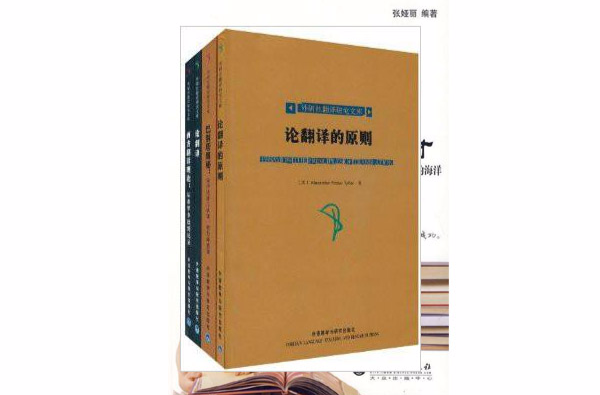《翻譯研究入門必讀》一書從“外研社翻譯研究文庫”中精選了四本書,內容豐富、全面、詳細易懂。 包括:《論翻譯的原則》、《西方翻譯理論:從希羅多德到尼采》、《巴別塔秘密:同聲傳譯與認知、智力和感知》、《論翻譯》。該書雖為學術研究著作,然全書行文深入淺出,語言表達生動,並配有大量現場的例子及形象的插圖,對於普通讀者來說,也是一本提高語言交際能力的平易而又實用的參考讀物。
基本介紹
- 書名:翻譯研究入門必讀
- 頁數:956頁
- 出版社:外語教學與研究出版社
- 開本:16
圖書信息,作者簡介,目錄,
圖書信息
出版社: 外語教學與研究出版社; 第1版 (2007年6月1日)
叢書名: 外研社翻譯研究文庫
平裝: 956頁
正文語種: 英語
開本: 16
ISBN: 9787560000008
條形碼: 9787560000008
尺寸: 22.8 x 15.6 x 5.2 cm
重量: 1.5 Kg
作者簡介
作者:(英國)泰特勒(Alexander Fraser Tytler) (阿根廷)貝爾托內(Laura E.Bertone) (英國)紐馬克(Peter Newmarket) 等
勞拉·貝爾托內(Laura E. Beltone),是巴黎大學的語言學博士,從事跨文化研究及普通語義學研究,並擁有20餘年國際會議傳譯的經驗。在《巴別塔揭秘:同聲傳譯與認知、智力和感知》這部新作中,作者以其獨特的視角,從國際會議口譯的實踐中擷取典型例子,試圖探索並解釋人類的感知、認知及智力的機制,尤其是人類語言交際的外在特點和內在機制,即,“巴別塔隱蔽的一面”(the hidden side of Babel)。
就其學術價值而言,本書不僅能為譯員反思其會議口譯活動提供指引,而且對於那些對人類認知活動及人類語言機制感興趣的人來說也是一部視角獨特的參考書;本書不僅對口譯研究者和譯員有參考作用,而且能為語言研究者開拓思路,為語言工作者拓寬視野。
彼得·紐馬克(Peter Newmark),是一位語言學家、翻譯家、翻譯教授和實踐型的翻譯理論家。從翻譯實踐出發,又以翻譯實踐為歸宿,紐馬克對翻譯理論和翻譯教學有其獨特的看法。《論翻譯》是他的第三部著作,收錄了他的13篇論文,內容龐雜,幾乎涉及到翻譯中的各種問題,是其在翻譯實踐的基礎上對翻譯所涉及的種種問題所作的理性思考,是其翻譯思想發展的一個新起點。
1791年,英國愛丁堡大學歷史學教授亞歷山大·弗雷澤·泰特勒(AIexander Fraser Tytler,1747-1814)在其所著的《論翻譯的原則》(Essay on the Principles of,Translation)一書中提出了著名的“翻譯三原則”,標誌著西方譯學研究從此走上了從理論推證理論的道路。故而,將《論翻譯的原則》譽為西方現代譯學研究的開山之作並不為過。
在國內學界,“翻譯三原則”幾乎人人耳熟能詳,正如嚴復的“信、達、雅”一樣如雷貫耳。但遺憾的是,國內讀過原著者寥寥,學界不得不轉來轉去地二手引用。希望本書的出版有助於研究者養成讀原著的習慣。
目錄
《論翻譯的原則》目錄:
Introduction
CHAPTER I
Description of a good Translation-General Rules
flowing from that description
CHAPTER II
First General Rule: A Translation should give a complete transcript of the ideas of the original work——Knowledge of the language of the original, and acquaintance with the subject——Examples of imperfect transfusion of the sense of the original ——What ought to be the conduct of a Translator where the sense is ambiguous
CHAPTER III
Whether it is allowable for a Translator to add to or retrench the ideas of the original-Examples of the use and abuse of this liberty
CHAPTER IV
Of the freedom allowed in poetical Translation——Progress of poetical Translation in England——B. Johnson, Holiday, May, Sandys, Fanshaw Dryden——Roscommon's Essay on Translated Verse——Pope's Homer
……
《西方翻譯理論:從希羅多德到尼采》目錄:
Editor's Preface
Herodotus
The Twittering of Birds
From Istoria, Book Two (mid-5th century B.C.E.)
The Origin of the Class of Egyptian Interpreters
From Istoria, Book Two (mid-5th century B.C.E.)
Anonymous ('Aristeas')
The Work of the Seventy-Two
From Aristeas to Philocrates (around 130 B.C.E.)
Marcus Tullius Cicero
Translating Greek Orations into Latin
From De oratore (55 B.C.E.)
The Best Kind of Orator (46 B.C.E.)
Translating Greek Philosophy into Latin
From De finibus bonorum et malorum (45-44 B.C.E.)
Philo Judaeus
The Creation of the Septuagint
From De vita Mosis (20 B.C.E.?)
Horace (Quintus Horatius Flaccus)
Imitating in Your Own Words
From Ars Poetica (20 B.C.E.?)
Paul of Tarsus
Rather Five Words with the Mind Than Ten Thousand in a Tongue
1 Corinthians 14 (55 C.E.?)
Lucius Annaeus Seneca
What Is
From Epistulae morales ad Lucilium, letter 58 (63-65 C.E.)
Pliny the Younger (Gaius Plinius Caecilius Secundus)
Imitation of the Best Models
Letter to Fuscus Salinator (85 C.E.?)
Quintilian (Marcus Fabius Quintilianus)
On What We Should Employ Ourselves When We Write
From Institutio oratoria(96 C.E.?)
Aulus Gellius
On the Importance of Avoiding Strict Literalness
From Noctes Atticae (100 C.E.?)
Epiphanius of Constantia (Salamis)
Producing an Unadulterated Translation
From De mensuris et ponderibus (392)
……
《巴別塔秘密:同聲傳譯與認知、智力和感知》目錄:
Introduction
The Fabulous Mystery of Language
The World of Conference Interpreting
A Little History
PART I
MESSAGES AND CONTENTS
What the Interpreter Soys
Chapter 1. Language as a Game
From Words to Acts
Stereotyping
Context
Point of View
Chapter 2. This Side of Words and Beyond theft
An Out of the Ordinary Invitation
The Physical Weight of Words
Chapter 3. The Implied
The Implicature in the Uttcrance
The Implicature in Enunciation
The Melody in Words
The Hidden Side of Words
The Slippery Notion of.Truth in Language
Chapter 4. The Motive
The Interpreter as a Bridge
Motivation
Chapter 5. Divergent or Contradictory Signals.
Contradictions
Manipulation
Chapter 6. The Two Axes
Conscious and Unconscious Acts of
Perception and Memory
Chapter 7. Simultaneity of Operations
The Concept of the Whole
……
《論翻譯》目錄:
Introduction
1 Translation as Means or End - As Imitation or Creation
2 Translation: An Introductory Survey
3 Translation Today: The Wider Aspects of Translation
4 Translation for Language Teaching and Professional Purposes
5 The Use of Systemic Linguistics in Translation
6 The Virtues of Interference and the Vices of Translationese
7 Word and Text: Words and Their Degree of Context in Translation..
8 Translation and Mis-translation: The Review, the Revision, and the Appraisal of a Translation
9 Pragmatic Translation and Literalism
10 Teaching Translation
11 Teaching about Translation
12 The Translation of Political Language
13 Translation as an Instrument of Linguistic, Cultural and
Literary Criticism
References
Index

